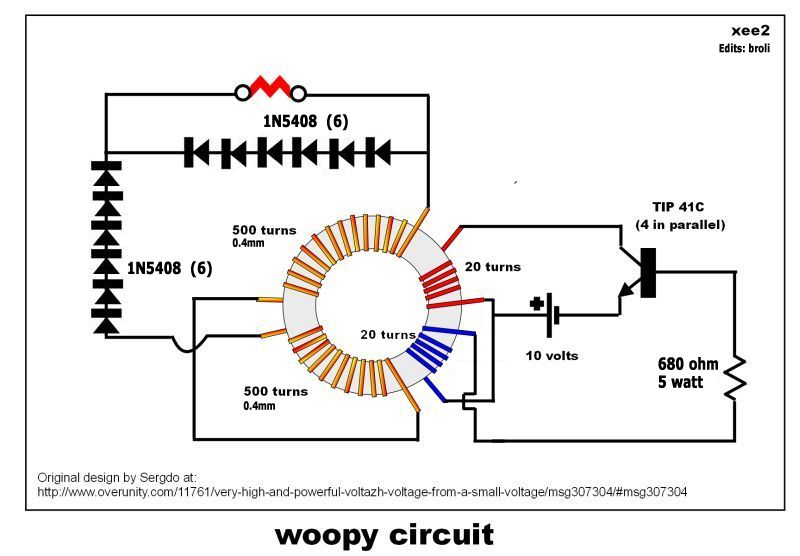@BrOnsOn77 - Interesting heat issue. It seems to me, that the resistance of the Primary may not be high enough...but is just a guess. When building traditional Tesla towers, the Primary is the area that can greatly affect amp draw. A normal small Slayer Exciter type of tower system will use a Primary of a couple of turns of wire (whereas Lasersaber uses a full amount of turns as his). If you increase the number of turns, the amp draw will go down, but the output will go down too. Decrease and the amps go up, yet the output might not change much. That's the balancing act to be played with such systems.
So, I wonder if your thicker gauge wiring is where the large amp draw is coming from. Being as it's a toroid and not a straight piece of ferrite, the recirculating energies might be playing a part ? I'm sure others will know more than I, but just a thought.
I've destroyed plenty of MOSFET's doing something similar with 12V non controlled amperage. They fizz and hiss and then go 'plink' as they hit the floor of the plastic kitchen bin !
I was saying earlier about the draw being only what the circuit will need. Thing is, if there is no restriction to that flow of current, it won't put a stop on the current. hence this thing about looking at the Primary winding for resistance. A resistor on the Collector output might be a route, to simulate extra turns.
@All -
With various folks talking about the ferrite tubes found around cabling, I wound one up for this SJR 3.0 circuit.
We know the SJR 3.0 will light a variety of bulbs...how about crossing that to charging different types of batteries ?
Well, it looks like it blasts dendrites, rejuvenates busted cells and the extra bonus is that it does so in just a few seconds !
I fully expect the few seconds effect to be a gateway for charging regularly, but, as shown in the video, 2x dead alkalines charged in a few seconds to return to running a kitchen temperature meter !
This build also features a handy 'ON' indicator, which also shows coil loadings by the brightness of the LED. It's a wireless energy pickup, made from a coil from a floppy drive motor assembly and an LED soldered to its wires. If the circuit isn't outputting HV, the LED won't come on, so it makes a great circuit checker.
Here's the video:
Super Turbo Battery Charger - YouTube
Pic of the circuit:

So, I wonder if your thicker gauge wiring is where the large amp draw is coming from. Being as it's a toroid and not a straight piece of ferrite, the recirculating energies might be playing a part ? I'm sure others will know more than I, but just a thought.
I've destroyed plenty of MOSFET's doing something similar with 12V non controlled amperage. They fizz and hiss and then go 'plink' as they hit the floor of the plastic kitchen bin !
I was saying earlier about the draw being only what the circuit will need. Thing is, if there is no restriction to that flow of current, it won't put a stop on the current. hence this thing about looking at the Primary winding for resistance. A resistor on the Collector output might be a route, to simulate extra turns.
@All -
With various folks talking about the ferrite tubes found around cabling, I wound one up for this SJR 3.0 circuit.
We know the SJR 3.0 will light a variety of bulbs...how about crossing that to charging different types of batteries ?
Well, it looks like it blasts dendrites, rejuvenates busted cells and the extra bonus is that it does so in just a few seconds !
I fully expect the few seconds effect to be a gateway for charging regularly, but, as shown in the video, 2x dead alkalines charged in a few seconds to return to running a kitchen temperature meter !
This build also features a handy 'ON' indicator, which also shows coil loadings by the brightness of the LED. It's a wireless energy pickup, made from a coil from a floppy drive motor assembly and an LED soldered to its wires. If the circuit isn't outputting HV, the LED won't come on, so it makes a great circuit checker.
Here's the video:
Super Turbo Battery Charger - YouTube
Pic of the circuit:







Comment